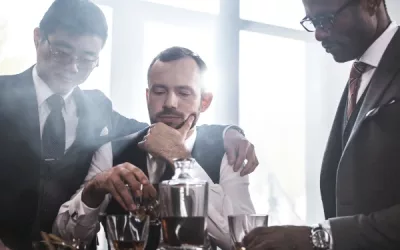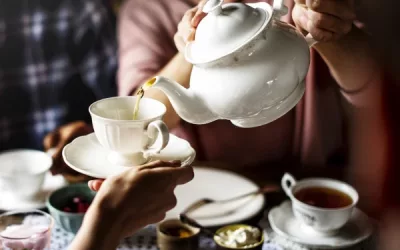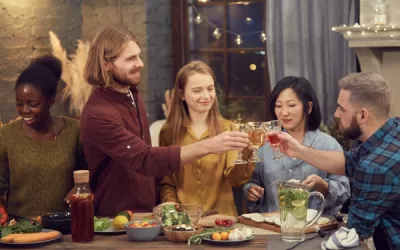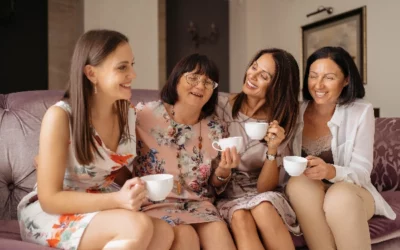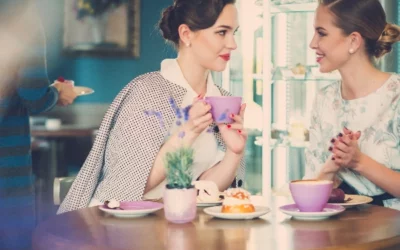I still remember my first experience with afternoon tea. I walked into a quaint little tearoom, the sweet aroma of freshly baked scones filled the air. As I took my seat, a sense of excitement bubbled up inside me. But as the waiter brought out a beautiful selection of sandwiches and pastries, I suddenly felt a wave of uncertainty. What do I eat first? How should I behave?
If you’ve ever felt the same way or if you’re eager to host your own afternoon tea, this guide is just for you. We’ll explore the elegant world of afternoon tea etiquette — from the proper order to eat, to the essential dos and don’ts, and even what to wear. So grab your teacup and let’s master the art of enjoying this delightful British tradition together!
Table of Content
- What is the correct order to eat afternoon tea?
- What are the essential dos and don’ts of afternoon tea etiquette?
- How should one dress for an afternoon tea?
- How should tea be served and consumed?
- What are the traditional foods served at an afternoon tea?
- How to engage in polite conversation during afternoon tea?
- What is the historical and cultural significance of afternoon tea?
- How did afternoon tea originate?
- How has afternoon tea evolved over time?
- What are some famous afternoon tea traditions?
- Conclusion
What is the correct order to eat afternoon tea?
The term “afternoon tea” conjures images of elegance, fine china, and delicate delectables arranged on a tiered stand. The order in which these items are consumed isn’t random; it follows a traditional sequence aimed at enhancing the dining experience. This sequence often starts with sandwiches, moves on to scones, and concludes with pastries. Each element in this progression has a purpose and contributes to the overall enjoyment of the tea.
Understanding the sequence helps you appreciate the nuances that make afternoon tea a cherished British tradition. Let’s break down the steps and uncover the reasoning behind them.
Why is it important to start with sandwiches?
Commencing with sandwiches is a hallmark of traditional afternoon tea. These savoury bites:
- Cleanse the palate and whet the appetite
- Offer a variety of flavours and textures to gently begin the meal
- Include classic fillings like cucumber, smoked salmon, egg and cress, and ham with mustard
These light yet flavourful sandwiches set the stage perfectly for richer and sweeter elements to come. Skipping straight to sweets might overwhelm your taste buds and diminish the full experience. By starting savoury, you ease into the meal, allowing yourself to fully appreciate the subsequent offerings.
How should scones be prepared and eaten?
Scones serve as the heart of any afternoon tea experience. The ritual of preparing and eating scones involves:
- Splitting the scone into halves with your hands (not using a knife)
- Spreading clotted cream first, followed by jam (or vice versa, depending on regional preferences like Devonshire vs Cornish styles)
- Savouring each bite slowly to enjoy the crumbly, rich texture
Scones bridge the gap between savoury sandwiches and sweet pastries, offering a mildly sweet, buttery conversation. The clotted cream adds a layer of indulgence, while the jam brings in fruity notes. The act of layering these condiments is almost as delightful as eating them.
What is the significance of ending with pastries?
Finishing with pastries not only provides a sweet conclusion but also:
- Allows you to enjoy these delicacies without other strong flavours competing
- Includes an array of treats like éclairs, fruit tarts, and macarons to satisfy your sweet tooth
- Marks a celebratory end to the tea with luxurious, often intricate desserts
Ending on a sweet note lifts the entire experience. Each pastry, usually crafted with intricate detail, feels like a small piece of art that caps off the meal gracefully. By this time, your palate is ready for richer, sugary flavours without being overwhelmed.
During the height of the British Empire, afternoon tea became a widespread tradition, even aboard ships that travelled to and from colonies. It is said that Queen Victoria, an ardent tea enthusiast, would insist on adhering to this sequence during sea voyages. Amidst opulent settings, Victorian high society would still observe these rituals, eagerly starting with delicate sandwiches and saving the best, elaborate pastries for last.
I remember hosting my first afternoon tea after a visit to London where I experienced it first-hand. I followed the traditional sequence, starting with cucumber sandwiches. My friends and I then moved onto buttery scones with clotted cream and strawberry jam, each step savoured. Finally, we concluded with mini tarts and eclairs, feeling quite sophisticated. The order not only elevated the taste but also added an air of authenticity that impressed everyone.
What are the essential dos and don’ts of afternoon tea etiquette?
Afternoon tea etiquette has been a cherished part of British culture for centuries. Whether you’re attending a formal tea party at a grand hotel or hosting an intimate gathering at home, understanding the rules will ensure you make a lasting, positive impression. To get the most out of your afternoon tea experience, it’s essential to know the dos and don’ts to follow. I’ve created a table that will help you easily understand what is considered polite and acceptable, and what to avoid.
This table highlights the essential dos and don’ts of afternoon tea etiquette. Use this guide to navigate your next afternoon tea event confidently.
Dos and Don’ts of Afternoon Tea Etiquette
| Dos | Don’ts |
|---|---|
| Keep your pinkie down | Slurp or blow on your tea |
| Hold the teacup by the handle | Dunk biscuits or scones in your tea |
| Place the napkin on your lap | Overfill your teacup |
| Stir your tea gently and quietly | Use your fingers to eat pastries |
| Use a soft tone of voice | Start eating before everyone is served |
| Break scones with your hands | Use your smartphone at the table |
| Thank your host before leaving | Pour milk first before tea |
Understanding these guidelines:
- Keep your pinkie down: It might seem posh to stretch your pinkie while drinking tea, but it’s considered pretentious.
- Hold the teacup by the handle: Proper etiquette suggests holding the teacup by the handle to avoid spillage.
- Place the napkin on your lap: This prevents any accidental crumbs or spills on your attire.
- Stir your tea gently and quietly: Loud stirring can be disruptive; a gentle stir keeps the environment peaceful.
- Use a soft tone of voice: Afternoon tea is a time for relaxed conversation, not loud discussions.
- Break scones with your hands: Use your hands to break scones into halves before applying cream or jam.
- Thank your host before leaving: A little gratitude goes a long way, showing respect and appreciation for the invitation.
Conversely:
- Slurp or blow on your tea: This can be considered rude and disruptive.
- Dunk biscuits or scones in your tea: Traditional etiquette frowns upon this as it can cause crumbs and mess.
- Overfill your teacup: Leave a little room to avoid spilling when lifting the cup.
- Use your fingers to eat pastries: Use a fork instead to maintain decorum.
- Start eating before everyone is served: Wait until everyone has their tea and food before you begin.
- Use your smartphone at the table: Keep your phone away to focus on the social interactions.
- Pour milk first before tea: Traditionally, tea is poured first, and then the milk is added.
The history of afternoon tea is fascinating. Anna, the Duchess of Bedford, is credited with introducing this tradition in the early 1840s. She would often feel peckish in the late afternoon, so she began the custom of enjoying tea and light snacks in her private quarters. Eventually, she started inviting her friends to join, and afternoon tea became a formal social event amongst British high society. The custom spread, and it remains a beloved tradition today.
I remember hosting my first afternoon tea for friends. I was nervous about following all the correct etiquette rules, but it turned out to be a delightful experience. We enjoyed mini sandwiches, scones with clotted cream and jam, and a variety of pastries.
Undoubtedly, it was a memorable afternoon, filled with laughter and elegant sips of Earl Grey. By adhering to these simple dos and don’ts, you’ll find that the ritual can be wonderfully enjoyable!
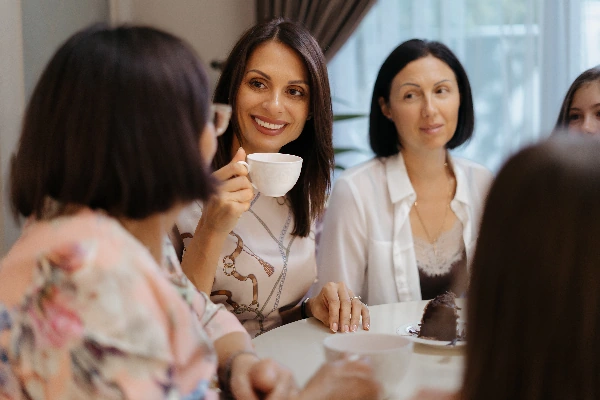
How should one dress for an afternoon tea?
Alright, so you’ve got an invitation to an afternoon tea. Congrats! But now you’re probably staring at your wardrobe, totally at a loss about what to wear. Don’t worry; I’ve got you covered. Dressing for an afternoon tea is like nailing an audition for “The Crown” – you want to look posh enough that the Queen herself might nod approvingly, but not so stuffy you can’t enjoy your scones and clotted cream.
Afternoon tea is more than just tea and cakes; it’s a mini-ceremony soaked in etiquette and tradition. This genteel custom has roots deep in British culture, so how you dress plays a significant role.
You can read our complete guide on what to wears for afternoon tea here, or you can get the key points below.
What is considered formal attire for afternoon tea?
Let’s cut straight to the chase. Formal attire doesn’t mean you need to whip out a ball gown or a tuxedo. Keep it elegant, semi-formal, and oh-so-refined.
- Men: Think smart. A tailored suit or at least a crisp shirt with a blazer and slacks. Ditch the tie if you must, but keep the jacket.
- Women: A dress or a smart two-piece ensemble, maybe even a chic skirt with a blouse. Think Audrey Hepburn in “My Fair Lady” but dialed down a notch.
- Footwear: Polished shoes for men, and elegant flats or low heels for women. Leave sporty trainers for the gym.
- Accessories: Minimal but classy. Gents, a nice watch or cufflinks will do. Ladies, maybe a tasteful necklace or a hat – yes, channel your inner royal.
Opt for an outfit that screams “I’ve just gotten back from Kensington Palace,” not “I’ve just rolled out of bed.”
Why should casual wear be avoided?
So, you’re thinking of wearing jeans and a graphic t-shirt with a witty slogan? Okay, let’s stop right there. Casual wear is a big no-no, and here’s why:
- Respect the Tradition: Afternoon tea has a long, opulent history; treating it casually is like bringing a hot dog to a fine dining restaurant.
- Ambiance Match: You’re often in lavish surroundings – posh hotels or elegant tearooms – and you don’t want to look like a fish out of water.
- Social Etiquette: It’s about respecting your host and fellow attendees. You wouldn’t wear flip-flops to a wedding, would you?
- First Impressions Last: Whether it’s networking or a family affair, you want to leave a mark, the good kind.
- Instagram-worthy: Let’s be honest, would your trainers and hoodie look good in those vintage tearoom snapshots?
When someone is pouring you the finest Earl Grey, the least you can do is look the part.
Are there any seasonal dress code variations?
Absolutely, darling! Just because we’re talking tradition doesn’t mean we can’t be sensible about the weather. Dress with the season in mind, but never stray far from that semi-formal base.
- Spring: Light pastels, floral patterns, airy fabrics like linen or cotton. A light cardigan or shawl can be your best friend.
- Summer: Go bright and breezy. Think breathable fabrics, lighter colours, and perhaps a sun hat or shades to complete the look.
- Autumn: Earthy tones, layered clothing, perhaps a stylish trench coat or a sophisticated scarf. Keep it cosy yet refined.
- Winter: Woollen trousers, long-sleeved dresses, and maybe even a classy shawl or pashmina. Think cosy, comfortable, and chic.
Dressing seasonally appropriately ensures you’re comfortable and stylish.
In the 1800s, the Duchess of Bedford started the whole afternoon tea tradition because she got peckish in the afternoons. Rather than grabbing an energy bar, she opted for a light meal of tea, sandwiches, and pastries, which soon became a fashionable social event. A big part of its charm then, just as now, was the delightful sense of occasion – and that includes looking the part.
So, next time you’re heading to an afternoon tea, remember, it’s not just about sipping tea and nibbling on finger foods. It’s about celebrating a cherished tradition with elegance, respect, and a touch of style. Now, off you go to find that perfect outfit!
What are the proper table manners during afternoon tea?
So, you’ve decided to plunge into the world of afternoon tea etiquette. Whether it’s because you want to impress your British in-laws, prepare for a posh tea party, or simply channel your inner Downton Abbey character, mastering these table manners is key. Let’s break down the essentials of how to behave so you don’t get the stink eye from your fellow tea enthusiasts.
How should one use napkins correctly?
Napkins might seem simple, but oh, how they can betray you! Here’s how to use them like a pro:
- Placement Rules: The minute your tush touches the chair, your napkin moves from the table to your lap. Not before, not after. Think of it as an unspoken pact.
- Mid-Meal Leave: Need to answer nature’s call? Leave your napkin on your chair. Placing it on the table prematurely is a faux pas.
- Dabbing, Not Wiping: Offer your mouth gentle dabs, not vigorous face-wiping sessions. Keep it classy, my friend.
- Exiting Gracefully: Done with your tea extravaganza? Make sure your napkin graces the left side of your plate. Fold it neatly – this isn’t a haphazard towel toss.
Clearly, the napkin is your silent dining companion, one that conveys more about your sophistication than you’d think.
What is the proper way to handle cutlery?
Cutlery etiquette is a labyrinth of dos and don’ts, but don’t fret—I’ve got your back:
- Scone Situation: Use your knife to split your scone, then slather it with clotted cream and jam. No cutting as if it’s a well-done steak.
- Teaspoon Tactics: When you’ve finished stirring your tea, place the teaspoon gently on the saucer. No one wants a messy table.
- Finger Food Only: Afternoon tea often includes dainty finger foods like sandwiches and pastries. Yes, it’s okay to use your hands. Cutlery is for the heavier, messier stuff.
- Cake Forks: For cakes, use a cake fork if provided. Trust us, it’s more elegant and makes you look like you know your stuff.
Mastering cutlery is a subtle art, one that turns a dining experience from awkward to elegant.
Why is good posture important?
Sit up straight, and no slouching! You’re at a tea party, not a front-row seat at a rock concert:
- Respectful Wingman: Posture shows respect to your host and to the occasion. Imagine serving tea in front of the Queen while hunched over – cringe!
- Cuisine Handling: Good posture aids in the smooth handling of tiny sandwiches, delicate pastries, and teacups without any tea-rrible spills.
- Engagement: Keeps you engaged in conversation, because it’s not just your jaw doing the work—your whole mien contributes.
So, treat that chair like a throne, and you’ll be halfway to mastering the art of tea etiquette.
Now let’s rewind the clock to the year 1840, when Anna, the 7th Duchess of Bedford, experienced a ‘sinking feeling’ in the late afternoon. This led her to sneak a tray of tea, bread, and butter to her room. Eventually, she started inviting friends, transforming a clandestine snack into the charming tradition we know today. Imagine if she had tipped her teacup over, or if her napkin was a mess. Afternoon tea etiquette not only adds to the charm but also preserves the grace of a timeless tradition.
How should tea be served and consumed?
Mastering the art of afternoon tea etiquette is a delightful venture into the refined world of British customs. Imagine yourself in the cosy parlour of Downton Abbey, attempting not to spill Earl Grey on a priceless Persian rug. But fear not, with these pearls of wisdom, you’ll navigate your way through tea-time like a pro.
When it comes to serving and consuming tea, it’s all about the delicate balance of tradition and precision. From how you handle your tea cup to the nuances of adding milk and sugar, each step is a dance of decorum and flair. Let’s dive into the rituals that make afternoon tea an experience to remember.
What is the correct way to hold a tea cup?
First things first, let’s talk about holding that delicate piece of porcelain without looking like a brute who’s grabbed it straight out of a pub.
- Hold the cup by the handle: Place your thumb and index finger at the top of the handle, with your middle finger supporting the bottom.
- Keep your pinky down: Contrary to popular belief, extending your pinky is a no-no. It’s an unnecessary flourish that has long been debunked as proper etiquette.
- Grip lightly: Avoid gripping the handle too tightly, as if you’re trying to strangle it. Grace and poise are key.
- Maintain balance: Steady the saucer with your other hand, particularly when seated. No one wants to dodge a flying tea cup.
Properly holding your tea cup is more about balancing it gently than clutching it like it’s the last doughnut in the office break room.
How should tea be poured?
Pouring tea might seem straightforward, but there’s a bit of a ritual here, akin to a sacred rite.
- Pre-warm the teapot: Swirl some hot water in your empty teapot and then discard it. This helps maintain the correct temperature of the tea.
- Use a tea strainer: If you’re using loose leaf tea, place a strainer over the cup to catch any errant leaves.
- Pour slowly: Start by filling each cup up to two-thirds full, allowing room for milk and sugar.
- Tea first or milk first: Traditionally, the milk goes in after the tea, especially if you’re using fine bone china, as the hot tea can crack a cold cup.
- Respect the guests: Always serve your guests first before pouring your own cup.
In short, pouring tea isn’t just filling a cup; it’s about honouring the elegance of the entire affair.
How to politely decline a refill of tea?
Ah, the delicate art of refusal! Declining a refill can be tricky, especially when you don’t want to appear rude or ungrateful.
- Use mannerly words: Simply say, “No, thank you” or “I’ve had my fill, thank you.”
- Lightly cover your cup: Place your hand or fingers gently across the top of your tea cup. This universal signal indicates that you don’t need more.
- Close the conversation with warmth: Add a complimentary note, like “That was a delightful cup, thank you.”
- Maintain eye contact: A warm smile and eye contact can soften the refusal, showing your appreciation without more tea.
There you have it – the gentle art of turning down more tea without offending your gracious host.
One memorable instance of tea etiquette in history involves Anna, the Duchess of Bedford, in the 1840s. She is credited with creating afternoon tea as a way to bridge the long gap between lunch and dinner. Seizing on her hunger one afternoon, she ordered tea, bread, and butter, and invited friends to join her.
This simple yet elegant affair caught on, and soon it became a beloved British tradition. So, as you sip your perfectly poured cup, remember you’re partaking in a noble pastime handed down through generations. Cheers – or rather, good afternoon!
What are the traditional foods served at an afternoon tea?
So, you’ve been invited to a proper British afternoon tea, or maybe you’re brave enough to host one yourself—either way, you want to know what’s on the menu, right? Let’s dig into the nitty-gritty of what you’ll typically find on an afternoon tea spread. It’s not just about dunking your biscuits; there’s a whole world of culinary delights awaiting you.
To give you the lowdown, we’re talking about:
- An array of delicate sandwiches.
- Scones that could make your granny proud.
- Pastries that belong more on Instagram than in your mouth.
- And the always-decadent clotted cream and jams.
Ready for your tastebuds to be tantalised? Let’s dive in!
What types of sandwiches are commonly served?
First off, let’s tackle the dainty yet delicious world of afternoon tea sandwiches. These aren’t your everyday ham and cheese sarnies; they’re dainty bites of heaven. The fillings are typically light and flavoursome, made to complement your tea rather than overwhelm it.
- Cucumber sandwiches: Thinly sliced cucumber with the crusts cut off. Often, cream cheese and herbs sneak in to elevate the taste.
- Egg and cress: A mix of hard-boiled eggs with a hint of mustard, mayonnaise, and a sprinkle of peppery cress.
- Smoked salmon: Pairing delicate smoked salmon with a spread of light cream cheese and perhaps a twist of lemon for that zing.
- Ham and mustard: Thin slices of honey-roasted ham, smeared with wholegrain mustard.
- Chicken salad: Shredded chicken mixed with a light seasoned mayonnaise, perhaps a hint of celery for crunch.
You see, it’s all about the balance of flavours and the sheer artistry of sandwich-making. These petite creations are as satisfying to the eyes as they are to the palate.
What makes scones a staple in afternoon tea?
Ah, scones—the crowning glory of afternoon tea. They’re more than just a food item; they’re a British institution. A good scone must be freshly baked, fluffy inside, with a slightly crispy exterior. Split them open, never cut (that’s just bad manners, mate), and spread on the clotted cream and jam. The eternal debate: which goes first, cream or jam? Frankly, it’s a matter of familial loyalty and taste buds.
Here’s why scones are a must:
- Texture: They strike the perfect balance between crumbly and soft.
- Versatility: Play with your topping choices—the classics being clotted cream and strawberry jam.
- Pairability: They perfectly complement a pot of freshly brewed tea.
- Simplicity: Basic ingredients like flour, butter, sugar, and milk rise to baked perfection.
- Tradition: It’s a nostalgic nod to British culture, invoking lazy Sunday afternoons and grandmotherly love.
If you haven’t had a warmed scone with a cup of tea, you haven’t lived. It’s pure comfort in every bite.
What are some popular pastries served?
Now, onto the pièce de résistance – the pastries. These bite-sized delights are the showstoppers of any afternoon tea tableau. Think of them as the grand finale that leaves everyone clapping (well, sipping) for more.
- Mini eclairs: Choux pastry filled with delicate cream, topped with a glossy coat of chocolate.
- Macarons: French, yes, but hugely popular. Light, crisp shells with rich, flavourful fillings.
- Battenberg: This checkerboard cake wrapped in marzipan is as pretty as it is delicious.
- Tarts: Assorted fruit tarts, with buttery, crumbly bases and sweet fruit toppings.
- Victoria sponge slices: Named after Queen Victoria, fluffy sponge cake with a jam and cream filling.
And don’t forget the petite fours! The variety of pastries at a traditional afternoon tea can make anyone feel like royalty. They’re crafted to look (and taste) exquisite, making you ponder, “Do I eat them or frame them?”
You see, traditional afternoon tea isn’t just a meal; it’s an experience, wrapped in elegance and steeped in history.
How to engage in polite conversation during afternoon tea?
Alright, so you’ve got your best outfit on, the scones are warm, and the tea is brewing. But hold up, there’s more to afternoon tea than just stuffing your face with clotted cream and cucumber sandwiches. Welcome to the world of polite conversation. Yep, it’s an art form and, just like any art form, it has its rules. Let’s jump into it, no time for faffing about.
The key ingredient in mastering this etiquette is avoiding those faux pas moments that make everyone want to crawl under the table and pretend to be the cat. We’ll tackle some nifty conversation starters, explain why you should steer clear of controversial topics, and outline the best ways to show appreciation during your natter.
What are some good conversation starters?
So, you’ve poured the tea and now you’re staring at your fellow tea-goers like deer caught in headlights. Don’t panic, you just need some icebreakers to get the chat flowing:
- Compliments: Classic, but gold. “I just love your dress, where did you get it?”
- Events: Mention a local event or something interesting in the news, but keep it light. “Have you heard about the flower show happening next week?”
- Books & Films: Everyone’s got an opinion. “Have you watched the latest film adaptation of Jane Austen’s Emma?”
- Holiday Plans: People love talking about their holidays. “Got any exciting plans for the summer?”
- Hobbies: It’s always a safe bet. “What do you like doing in your free time?”
Hit them with one of those, and viola! You’re off to a great start. These topics are safe and inclusive, making everyone feel comfortable.
Why should controversial topics be avoided?
We’ve all got that one loud uncle who loves to talk politics at every gathering – and it’s almost always a disaster. Afternoon tea isn’t the place for a showdown. Here’s why:
- Politeness: Etiquette is all about being polite and respectful. Controversial topics can quickly turn tea-time into debate club.
- Inclusivity: Not everyone has the same views. Avoiding hot topics ensures everyone feels included and no one feels awkward.
- Focus on Enjoyment: The point of afternoon tea is to enjoy time together, not to hash out conflicting opinions.
- Avoid Arguments: Keeping the chat light ensures no one’s day is ruined by a heated disagreement.
So leave the heavy stuff at the door and keep it breezy.
How to show appreciation during the conversation?
Now, if you’ve already nailed the first two parts, the last bit is just as crucial: showing that you’re an appreciative, attentive listener. Here’s how to do it like a pro:
- Nodding: It’s non-verbal but powerful. A simple nod shows you’re following along.
- Eye Contact: Important in any conversation. Keep it light but constant.
- Repeating: Paraphrasing what the other person said shows you’re really listening. “That’s fascinating, so you said you’ve been to three countries this year?”
- Thanking: Always thank your host or the person who made a particular point in the conversation. “Thanks for sharing that story, it was hilarious.”
- Asking Follow-up Questions: This shows genuine interest. “That’s a fantastic hobby! How did you get into it?”
By doing these, you’ll leave your tea companions thinking, “What a delightful person!”
Now, let me take you back in time, specifically to the early 1900s. Picture this: Lady Astor, the first woman to sit in the British House of Commons, was known for her wit and sharp comments during the tea breaks in the parliamentary halls. She had to navigate a room full of powerful, often not-so-welcoming men.
Yet, she did so with grace, knowing exactly how to turn the conversation with a charming wit – always steering clear of topics that could turn ugly, and instead, disarming her audience with self-deprecation and humour. If Lady Astor could manage that, you can surely manage a polite afternoon tea conversation!
So, next time you’re at an afternoon tea, remember: a little tact goes a long way. Now go, enjoy that cuppa and make some delightful chit-chat!
What is the historical and cultural significance of afternoon tea?
Ever wondered why Brits are so obsessed with afternoon tea? Let’s spill the tea—literally. The historical and cultural significance of afternoon tea goes beyond sipping a beverage. It’s a quintessentially British tradition steeped in history and culture.
This delightful custom traces its roots back to the early 19th century, specifically to Anna, the Duchess of Bedford, who couldn’t bear the “sinking feeling” in the long gap between lunch and dinner. What’s a hungry duchess supposed to do? She had some tea with a bite to eat, and voilà: afternoon tea was born.
It’s no surprise the practice quickly spread among the aristocratic crowd. Who could resist an excuse to nibble on delicate sandwiches and pastries while flaunting their posh bone china? Over time, afternoon tea trickled down to the wider public and became an essential part of British life.
Today, we’re still raising our pinkies, but afternoon tea has evolved. What once was an aristocratic pastime has now become a global phenomenon, influenced by modern twists and flavours. Think themed teas, infusion variations, and unique pairings.
How did afternoon tea originate?
Picture this: it’s the 1840s, and Anna, the Duchess of Bedford, is famished by mid-afternoon. Dinner won’t be served until much later, and lunch feels like it happened in another era. So, she requests a small meal in her boudoir: tea, bread and butter, and little cakes. The idea catches on like wildfire, and soon, all of high society is following suit.
Afternoon tea was a solution to a practical problem—no one enjoys being hungry. But it also created a social opportunity. It became a daily event where aristocrats mingled, shared gossip, and flaunted their latest fashions. The Duchess’s light-bulb moment fostered a new cultural ritual that’s as much about camaraderie as it is about refreshments.
So next time you’re sipping Earl Grey with a scone, remember: you’re participating in history.
How has afternoon tea evolved over time?
Our beloved afternoon tea has come a long way from its aristocratic beginnings. Originally, it was a small, intimate affair involving tea, bread, butter, and cake. A modest little get-together. But oh, how times have changed!
- Victorian Expansion: Queen Victoria made afternoon tea a grand affair. Out went the simple fare, in came a lineup of sandwiches, savouries, scones, and cakes. It became a social rite.
- High Tea Misconception: Don’t confuse afternoon tea with high tea. High tea was the working man’s supper—more robust dishes like meat pies and fish, taken at the end of the day. Think heavy machinery, not delicate china.
- Modern Twists: Today, hotels and tearooms put their stamp on tradition. From themed teas (like Alice in Wonderland) to infusing exotic flavours, there’s an endless array of choices.
- Global Reach: Afternoon tea has travelled far from British shores. It’s enjoyed globally, from chic Tokyo cafés to elegant New York hotels.
Despite these changes, the core essence—hospitality, refinement, and socialising—remains intact.
What are some famous afternoon tea traditions?
Now, let’s dive into some famous afternoon tea traditions that have stood the test of time:
- The Ritz London: If you’re looking for quintessential afternoon tea, The Ritz is your destination. Known for its opulent setting and impeccable service, this is afternoon tea done right.
- The Tower of London: Fancy a spot of tea with some history? Afternoon tea here includes stunning views and possibly a beefeater sighting.
- Cream Tea in Devon and Cornwall: Ah, the age-old scone debate. Devon serves its scones with clotted cream first, then jam—Cornwall does the opposite. Choose your side wisely!
- Jane Austen Festival: Ever fancied tea with Elizabeth Bennet? This festival in Bath offers a period luxury experience, complete with regency attire.
- Themed Teas: From Harry Potter-inspired brews to literary-themed repasts, modern adaptations keep things fresh and fun.
Each tradition adds its unique flavour to the grand tapestry of afternoon tea experiences, making it an ever-evolving ritual.
And now, a quick detour into the annals of history. Speaking of tradition, let’s talk about Sir Joseph Banks. This 18th-century botanist and explorer introduced many plants to Britain, but did you know he popularised the concept of the plant exploration society?
Just as the Duchess of Bedford had her influence on customs, Banks shaped the way we look at flora. Imagine him at an afternoon tea, droning on about exotic plants while nibbling on a cucumber sandwich. Talk about blending history with culture!
Hope you found this trip through afternoon tea’s history as delightful as a well-steeped pot of Darjeeling. Cheers!
Conclusion
Reflecting on the art of afternoon tea etiquette, it becomes clear that this rich tradition is as much about the experience as it is about the rules. We’ve journeyed through the correct order to enjoy the delicate components of a proper afternoon tea, from the savoury sandwiches to the delightful pastries that cap the experience.
Each aspect of this custom, from the dos and don’ts highlighted in the table, to the tasteful dressing and impeccable table manners, serves to create an atmosphere that cherishes social interaction and elegance.
Recognising the importance of these etiquettes is crucial, as they not only enrich our own experiences but also honour those with whom we share such moments. The historical and cultural significance tied to afternoon tea is a reminder of how food and drink can forge connections across generations, reflecting the evolution of societal norms and familial practices.
As we consider implementing these guidelines into our own afternoon tea gatherings or exploring this cultural experience in our communities, I encourage an open mind and an appreciation for these time-honoured traditions. Perhaps next time we find ourselves at a teapot-laden table, we can not only enjoy the delectable offerings but also engage in meaningful conversations that elevate the occasion.
In closing, I leave you with this thought: how can we take these lessons of etiquette and apply them to our everyday interactions, fostering a greater sense of community in our fast-paced lives? Just as afternoon tea offers a moment to pause and connect, may we seek to create similar spaces for reflection and camaraderie in our day-to-day encounters. After all, every cup of tea shared is a step towards greater understanding and friendship.


